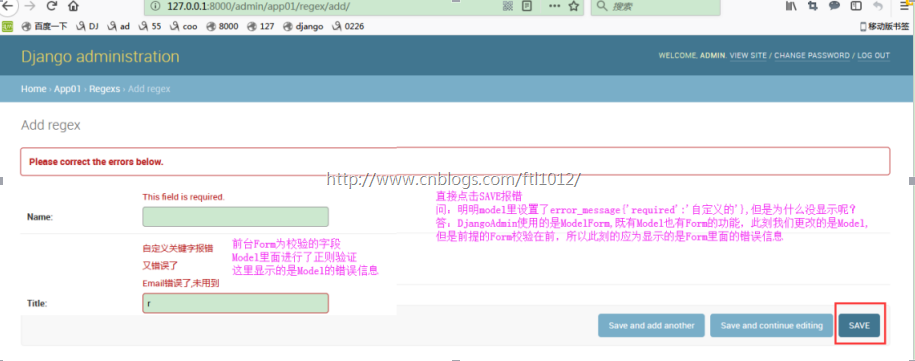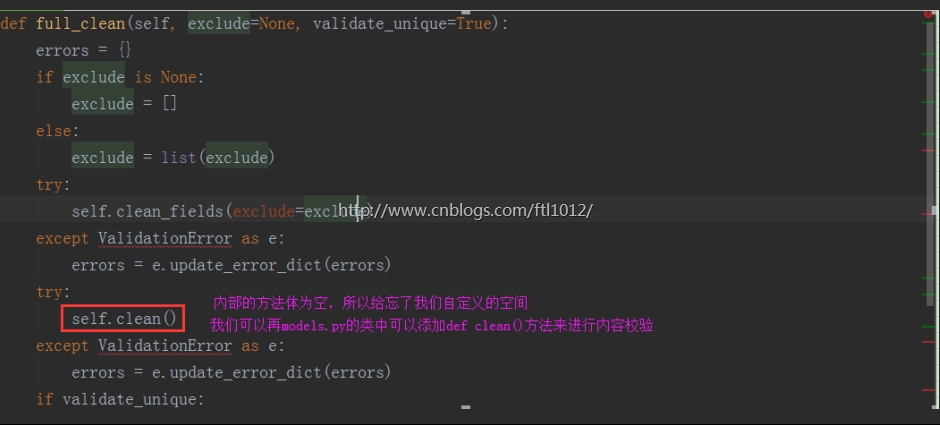Python学习---Model拾遗[2]180318
Model的字段及字段参数:
Model字段:
数字
字符串(带正则的字段)
时间
文件
特殊字段:(一对一,一对多,多对多)
Models.py
1 2 3 4 5 6 7 8 9 10 11 | class UserProfile(models.Model): pwd = models.CharField(max_length=32) email = models.EmailField() # 有Email验证功能,但是在model里未使用【ModelForm有用到】 timeStack = models.DateTimeField() # 时间模块 binary = models.BinaryField() # 二进制模块 file = models.FileField(upload_to='upload') # 页面生成input框,数据库内存储字符串,ModelForm里存储文件 # 页面生成input框,且上传图片会获取到文件大小并赋值给w和h # 这里是利用Pillow模块实现,如未安装Pillow,使用ImageField会报错 w = models.IntegerField() # 获取Img的大小赋值给w h = models.IntegerField() # 获取Img的大小赋值给h img = models.ImageField(upload_to='img',width_field='w', height_field='h')# 注意w和h添加引号的 |
Model字段参数
Model参数: 用于指定数据库列的信息(eg.列名别名,是否添加索引等)
用于验证(admin, ModelForm)
关系(一对一,一对多,多对多)
1 2 3 4 5 6 7 8 9 10 11 12 13 14 15 16 17 18 19 20 21 22 | null 数据库中字段是否可以为空db_column 数据库中字段的列名default 数据库中字段的默认值primary_key 数据库中字段是否为主键db_index 数据库中字段是否可以建立索引unique 数据库中字段是否可以建立唯一索引unique_for_date 数据库中字段【日期】部分是否可以建立唯一索引unique_for_month 数据库中字段【月】部分是否可以建立唯一索引unique_for_year 数据库中字段【年】部分是否可以建立唯一索引verbose_name Admin中显示的字段名称blank Admin中是否允许用户输入为空editable Admin中是否可以编辑help_text Admin中该字段的提示信息choices Admin中显示选择框的内容,用不变动的数据放在内存中从而避免跨表操作 如:gf = models.IntegerField(choices=[(0, '何穗'),(1, '大表姐'),],default=1)error_messages 自定义错误信息(字典类型),从而定制想要显示的错误信息; 字典健:null, blank, invalid, invalid_choice, unique, and unique_for_date 如:{'null': "不能为空.", 'invalid': '格式错误'}validators 自定义错误验证(列表类型),从而定制想要的验证规则 |
简单的使用:
1 2 3 4 5 6 7 8 9 10 11 12 13 14 15 16 17 18 19 | from django.core.validators import RegexValidatorfrom django.core.validators import EmailValidator,from django.core.validators import URLValidator,MinLengthValidatorfrom django.core.validators import DecimalValidator,from django.core.validators import MaxLengthValidator,from django.core.validators import MaxValueValidator,MinValueValidator 如: test = models.CharField( max_length=32, error_messages={ 'c1': '优先错信息1', 'c2': '优先错信息2', 'c3': '优先错信息3', }, validators=[ RegexValidator(regex='root_\d+', message='错误了', code='c1'), RegexValidator(regex='root_112233\d+', message='又错误了', code='c2'), EmailValidator(message='又错误了', code='c3'), ] ) |
这里重点介绍Model中validators和error_message的用法:
models.py
1 2 3 4 5 6 7 8 9 10 11 12 | <pre class="brush: sql; auto-links: true; collapse: false; first-line: 1; gutter: html-script: light: ruler: smart-tabs: tab-size: 4; toolbar:">from django.core.validators import RegexValidatorfrom django.core.validators import EmailValidator, URLValidator, DecimalValidatorfrom django.core.validators import MaxValueValidator, MinValueValidatorfrom django.core.validators import MaxLengthValidator, MinLengthValidatorclass Regex(models.Model): name = models.CharField(max_length=32, error_messages={'required':'Model里设置的错误信息error_message'},) title = models.CharField(max_length=32, error_messages={'c1': '自定义关键字报错'}, validators=[ RegexValidator(regex='root_\d+', message='错误了', code='c1'), RegexValidator(regex='root_112233\d+', message='又错误了', code='c2'), EmailValidator(message='Email错误了,未用到', code='c3'), ] )</pre><br><strong>注意:</strong><br> 1.ModelForm里面定义Form的优先级高于Model<br> 2.Model中title的error_message里面的自定义的代码是c1,页面显示的也是C1里面定义的内容,所以error_message比Validators的级别高。<br> 3.如果想定义中文显示,只能去DjangoAdmin里面修改ModelForm了 |
admin.py
1 2 3 | from django.contrib import adminfrom app01 import modelsadmin.site.register(models.Regex) |
页面显示:
初始化数据库
1 2 | python manage.py makemigrations python manage.py migrate |
多表关系以及参数
外键:
1 2 3 4 5 6 7 8 9 10 11 12 13 14 15 16 17 18 19 20 21 22 23 24 25 26 27 28 29 30 31 32 | ForeignKey(ForeignObject) # ForeignObject(RelatedField) to, # 要进行关联的表名 to_field=None, # 要关联的表中的字段名称 on_delete=None, # 当删除关联表中的数据时,当前表与其关联的行的行为 - models.CASCADE,删除关联数据,与之关联也删除 - models.DO_NOTHING,删除关联数据,引发错误IntegrityError - models.PROTECT,删除关联数据,引发错误ProtectedError - models.SET_NULL,删除关联数据,与之关联的值设置为null(前提FK字段需要设置为可空) - models.SET_DEFAULT,删除关联数据,与之关联的值设置为默认值(前提FK字段需要设置默认值) - models.SET,删除关联数据, a. 与之关联的值设置为指定值,设置:models.SET(值) b. 与之关联的值设置为可执行对象的返回值,设置:models.SET(可执行对象) def func(): return 10 class MyModel(models.Model): user = models.ForeignKey( to="User", to_field="id" on_delete=models.SET(func),) related_name=None, # 反向操作时,使用的字段名,用于代替 【表名_set】 如: obj.表名_set.all() related_query_name=None, # 反向操作时,使用的连接前缀,用于替换【表名】 如: models.UserGroup.objects.filter(表名__字段名=1).values('表名__字段名') limit_choices_to=None, # 在Admin或ModelForm中显示关联数据时,提供的条件: # 如: - limit_choices_to={'nid__gt': 5} - limit_choices_to=lambda : {'nid__gt': 5} from django.db.models import Q - limit_choices_to=Q(nid__gt=10) - limit_choices_to=Q(nid=8) | Q(nid__gt=10) - limit_choices_to=lambda : Q(Q(nid=8) | Q(nid__gt=10)) & Q(caption='root') db_constraint=True # 是否在数据库中创建外键约束 parent_link=False # 在Admin中是否显示关联数据 |
一对一:
1 2 3 4 5 6 7 8 9 10 11 | toto_fieldrelated_namerelated_query_namelimti_choices_to = {}verbose_nameselect_relatedprefetch_relatedon_deletedb_constraintparent_link: 是否创建父亲页面的显示 |
多对多:
【更多参考】http://www.cnblogs.com/wupeiqi/articles/6216618.html
Model之ORM操作大总结
基本操作+高级操作
1 2 3 4 5 6 7 8 9 10 11 12 13 14 15 16 17 18 19 20 21 22 23 24 25 26 27 28 29 30 31 32 33 34 35 36 37 38 39 40 41 42 43 44 45 46 47 48 49 50 51 52 53 54 55 56 57 58 59 60 61 62 63 64 65 66 67 68 69 70 71 72 73 74 75 76 77 78 79 80 81 82 83 84 85 86 87 88 89 90 | # 增models.Tb1.objects.create(c1='xx', c2='oo') # 增加一条数据,可以接受字典类型数据 **kwargs obj = models.Tb1(c1='xx', c2='oo') obj.save()# 查models.Tb1.objects.get(id=123) # 获取单条数据,不存在则报错(不建议)models.Tb1.objects.all() # 获取全部models.Tb1.objects.filter(name='seven') # 获取指定条件的数据models.Tb1.objects.exclude(name='seven') # 获取指定条件的数据# 删models.Tb1.objects.filter(name='seven').delete() # 删除指定条件的数据# 改 # 将指定条件的数据更新,均支持 **kwargsmodels.Tb1.objects.filter(name='seven').update(gender='0') # 修改单条数据obj = models.Tb1.objects.get(id=1)obj.c1 = '111'obj.save() # 获取个数 models.Tb1.objects.filter(name='seven').count()# 大于,小于 models.Tb1.objects.filter(id__gt=1) # 获取id大于1的值 models.Tb1.objects.filter(id__gte=1) # 获取id大于等于1的值 models.Tb1.objects.filter(id__lt=10) # 获取id小于10的值 models.Tb1.objects.filter(id__lte=10) # 获取id小于10的值 models.Tb1.objects.filter(id__lt=10, id__gt=1) # 获取id大于1 且 小于10的值# in models.Tb1.objects.filter(id__in=[11, 22, 33]) # 获取id等于11、22、33的数据 models.Tb1.objects.exclude(id__in=[11, 22, 33]) # not in# isnull models.Tbl.objects.filter(pub_date__isnull=True) # 获取条件为空# contains 模糊匹配 models.Tb1.objects.filter(name__contains="ven") models.Tb1.objects.filter(name__icontains="ven") # icontains大小写不敏感 models.Tb1.objects.exclude(name__icontains="ven")# range models.Tb1.objects.filter(id__range=[1, 2]) # 范围bettwen and# 其他类似 models.Tb1.objects.startswith() istartswith, endswith, iendswith,# order by models.Tb1.objects.filter(name='seven').order_by('id') # asc models.Tb1.objects.filter(name='seven').order_by('-id') # desc# annotate ==》group by from django.db.models import Count, Min, Max, Sum # 对Values里面的id进行groupBy,所以values必须放前面 # 前面的filter表示sql里面的where; 如果filter放在后面则表示Having models.Tb1.objects.filter(c1=1).values('id').annotate(c=Count('num')) SELECT "app01_tb1"."id", COUNT("app01_tb1"."num") AS "c" FROM "app01_tb1" WHERE "app01_tb1"."c1" = 1 GROUP BY "app01_tb1"."id"V = models.UserInfo.objects.values('u_id').annotate(uid=Count('u_id')) # SELECT u_id, COUNT(ui) AS `uid` FROM UserInfo GROUP BY u_id v = models.UserInfo.objects.values('u_id').annotate(uid=Count('u_id')).filter(uid__gt=1) # SELECT u_id, COUNT(ui_id) AS `uid` FROM UserInfo GROUP BY u_id having count(u_id) > 1 v = models.UserInfo.objects.values('u_id').annotate(uid=Count('u_id', distinct=True)).filter(uid__gt=1)# SELECT u_id, COUNT( DISTINCT ui_id) AS `uid` FROM UserInfo GROUP BY u_id having count(u_id) > 1# 切片:limit 、offset models.Tb1.objects.all()[10:20]# regex正则匹配,iregex 不区分大小写 Entry.objects.get(title__regex=r'^(An?|The) +') Entry.objects.get(title__iregex=r'^(an?|the) +')# date Entry.objects.filter(pub_date__date=datetime.date(2005, 1, 1)) Entry.objects.filter(pub_date__date__gt=datetime.date(2005, 1, 1))# year Entry.objects.filter(pub_date__year=2005) Entry.objects.filter(pub_date__year__gte=2005)# month Entry.objects.filter(pub_date__month=12) Entry.objects.filter(pub_date__month__gte=6)# day Entry.objects.filter(pub_date__day=3) Entry.objects.filter(pub_date__day__gte=3)# week_day Entry.objects.filter(pub_date__week_day=2) Entry.objects.filter(pub_date__week_day__gte=2)# hour Event.objects.filter(timestamp__hour=23) Event.objects.filter(time__hour=5) Event.objects.filter(timestamp__hour__gte=12)# minute Event.objects.filter(timestamp__minute=29) Event.objects.filter(time__minute=46) Event.objects.filter(timestamp__minute__gte=29)# second Event.objects.filter(timestamp__second=31) Event.objects.filter(time__second=2) Event.objects.filter(timestamp__second__gte=31) |
高级操作和其他操作:
1 2 3 4 5 6 7 8 9 10 11 12 13 14 15 16 17 18 19 20 21 22 23 24 25 26 27 28 29 30 31 32 33 34 35 36 37 38 39 40 41 42 43 44 45 46 47 48 49 50 51 52 53 54 55 56 57 58 59 60 61 62 63 64 65 66 67 | # F操作 from django.db.models import F models.Tb1.objects.update(num=F('num')+1)# Q操作 #方式一: Q(nid__gt=10) Q(nid=8) | Q(nid__gt=10) Q(Q(nid=8) | Q(nid__gt=10)) & Q(caption='root') # 方式二: con = Q() q1 = Q() q1.connector = 'OR' q1.children.append(('id', 1)) q1.children.append(('id', 10)) q1.children.append(('id', 9)) q2 = Q() q2.connector = 'OR' q2.children.append(('c1', 1)) q2.children.append(('c1', 10)) q2.children.append(('c1', 9)) con.add(q1, 'AND') con.add(q2, 'AND') models.Tb1.objects.filter(con)# extra: 自己写复杂是sql extra(self, select=None, where=None, params=None, tables=None, order_by=None, select_params=None) # select_params和select对应 # where 和 params对应 Tbl.objects.extra(select={'new_id': "1"},) # select XXX, 1 from Entry; ==> 第二列的数据为1 Tbl.objects.extra(select={'new_id': "select col from sometable where othercol > %s"}, select_params=(1,)) # select XXX, (select col from sometable where othercol > 1) as new_id from Entry; Tbl.objects.extra(where=['headline=%s'], params=['Lennon']) # select XXX from Entry where headline="Lennon"; Tbl.objects.extra(where=["foo='a' OR bar = 'a'", "baz = 'a'"]) # 双引号内是or条件,逗号是and条件 # select XXX from Entry where (foo='a' or bar='a') and baz='a'; ==>类似于Q的写法 Tbl.objects.extra(select={'new_id': "select id from tb where id > %s"}, select_params=(1,), order_by=['-nid']) # select XXX, (select col from sometable where othercol > 1) as new_id from Entry order by nid desc;# 执行原生SQL:适合sql复杂,Django解决不了用 from django.db import connection, connections cursor = connection.cursor() # cursor = connections['default'].cursor() 可选择操作数据库 cursor.execute("""SELECT * from auth_user where id = %s""", [1]) row = cursor.fetchone() row = cursor.fetchmany() # 多个数据库的使用:settings.py 这里定义了2个数据库,2个相同的数据库,可交叉使用,可一个读一个写DATABASES = { 'default': { 'ENGINE': 'django.db.backends.sqlite3', 'NAME': os.path.join(BASE_DIR, 'db.sqlite3'), } 'default1': { 'ENGINE': 'django.db.backends.sqlite3', 'NAME': os.path.join(BASE_DIR, 'db1.sqlite3'), }}models.Regex.objects.filter(id__lt = 4).using('default1') # 使用default1上面调用原生态sql的时候也可以使用from django.db import connection, connections cursor = connections['default1'].cursor() # 使用default1数据库 cursor.execute("""SELECT * from auth_user where id = %s""", [1]) row = cursor.fetchone() row = cursor.fetchmany() |
Model之QuerySet()方法剖析
1 2 3 4 5 6 7 8 9 10 11 12 13 14 15 16 17 18 19 20 21 22 23 24 25 26 27 28 29 30 31 32 33 34 35 36 37 38 39 40 41 42 43 44 45 46 47 48 49 50 51 52 53 54 55 56 57 58 59 60 61 62 63 64 65 66 67 68 69 70 71 72 73 74 75 76 77 78 79 80 81 82 83 84 85 86 87 88 89 90 91 92 93 94 95 96 97 98 99 100 101 102 103 104 105 106 107 108 109 110 111 112 113 114 115 116 117 118 119 120 121 122 123 124 125 126 127 128 129 130 131 132 133 134 135 136 137 138 139 140 141 142 143 144 145 146 147 148 149 150 151 152 153 154 155 156 157 158 159 160 161 162 163 164 165 166 167 168 169 170 171 172 173 174 175 176 177 178 179 180 181 182 183 184 185 186 187 188 189 190 191 192 193 194 195 196 197 198 199 200 201 202 203 204 205 206 207 208 209 210 211 212 213 214 215 216 | ################################################################### PUBLIC METHODS THAT ALTER ATTRIBUTES AND RETURN A NEW QUERYSET ###################################################################def all(self) # 获取所有的数据对象def filter(self, *args, **kwargs) # 条件查询 # 条件可以是:参数,字典,Qdef exclude(self, *args, **kwargs) # 条件查询 # 条件可以是:参数,字典,Qdef select_related(self, *fields) 性能相关:表之间进行join连表操作,一次性获取关联的数据。select_related()仅仅适用于外键字段进行关联,如果有多级的字段关联,多写2个下划线表示 model.tb.objects.all().select_related('外键字段') model.tb.objects.all().select_related('外键字段__外键字段')def prefetch_related(self, *lookups) 性能相关:多表连表操作时速度会慢,使用其执行多次SQL查询在Python代码中实现连表操作。 # 获取所有用户表 # 获取用户类型表where id in (用户表中的查到的所有用户ID) models.UserInfo.objects.all().prefetch_related('外键字段')# 第一次从数据库内获取符合条件的数据时,会获取到该数据中外键字段【假设有10个数据,其中2个符合要求】,从而在第三张表中查询符合条件的数据【2条数据】放入内存中,下次obj.user_type_cap获取内容的时候就会从内存中获取了,减少了数据库的操作。 from django.db.models import Count, Case, When, IntegerField Article.objects.annotate( numviews=Count(Case( When(readership__what_time__lt=treshold, then=1), output_field=CharField(), )) ) students = Student.objects.all().annotate(num_excused_absences=models.Sum( models.Case( models.When(absence__type='Excused', then=1), default=0, output_field=models.IntegerField() )))def annotate(self, *args, **kwargs) # 用于实现聚合group by查询 from django.db.models import Count, Avg, Max, Min, Sum v = models.UserInfo.objects.values('u_id').annotate(uid=Count('u_id')) # SELECT u_id, COUNT(ui) AS `uid` FROM UserInfo GROUP BY u_id v = models.UserInfo.objects.values('u_id').annotate(uid=Count('u_id')).filter(uid__gt=1) # SELECT u_id, COUNT(ui_id) AS `uid` FROM UserInfo GROUP BY u_id having count(u_id) > 1 v = models.UserInfo.objects.values('u_id').annotate(uid=Count('u_id',distinct=True)).filter(uid__gt=1)#SELECT u_id, COUNT( DISTINCT ui_id) AS `uid` FROM UserInfo GROUP BY u_id having count(u_id) > 1def distinct(self, *field_names) # 用于distinct去重 models.UserInfo.objects.values('nid').distinct() # select distinct nid from userinfo 注:只有在PostgreSQL中才能使用distinct进行去重def order_by(self, *field_names) # 用于排序 models.UserInfo.objects.all().order_by('-id','age')def extra(self, select=None, where=None, params=None, tables=None, order_by=None, select_params=None) # 构造额外的查询条件或者映射,如:子查询 Entry.objects.extra(select={'new_id': "select col from sometable where othercol > %s"}, select_params=(1,)) Entry.objects.extra(where=['headline=%s'], params=['Lennon']) Entry.objects.extra(where=["foo='a' OR bar = 'a'", "baz = 'a'"]) Entry.objects.extra(select={'new_id': "select id from tb where id > %s"}, select_params=(1,), order_by=['-nid']) def reverse(self): # 倒序 models.UserInfo.objects.all().order_by('-nid').reverse() # 注:如果存在order_by,reverse则是倒序,如果多个排序则一一倒序这个reserve会检查是否有order_by,有则倒叙,无责不操作。 all().reserver() 无效果 def defer(self, *fields): models.UserInfo.objects.defer('username','id') 或 models.UserInfo.objects.filter(...).defer('username','id') #映射中排除某列数据 def only(self, *fields): #仅取某个表中的数据 models.UserInfo.objects.only('username','id') 或 models.UserInfo.objects.filter(...).only('username','id') def using(self, alias): 指定使用的数据库,参数为别名(setting中的设置)################################################### PUBLIC METHODS THAT RETURN A QUERYSET SUBCLASS ###################################################def raw(self, raw_query, params=None, translations=None, using=None): # 执行原生SQL, 此时将数据库内查询的列对应到model里面的字段 models.UserInfo.objects.raw('select * from userinfo') # 如果SQL是其他表时,必须查询对象主键,且将名字设置为当前UserInfo对象的主键列名user是userinfo的字段,caption是userType的字段 models.UserInfo.objects.raw('select id,caption as user from ’其他表') # 为原生SQL设置参数 models.UserInfo.objects.raw('select id as nid from userinfo where nid>%s', params=[12,]) # 将获取的到列名转换为指定列名 name_map = {'first': 'first_name', 'last': 'last_name', 'bd': 'birth_date', 'pk': 'id'} Person.objects.raw('SELECT * FROM some_other_table', translations=name_map) # 指定数据库 models.UserInfo.objects.raw('select * from userinfo', using="default") ################### 原生SQL ################### from django.db import connection, connections cursor = connection.cursor() # cursor = connections['default'].cursor() cursor.execute("""SELECT * from auth_user where id = %s""", [1]) row = cursor.fetchone() # fetchall()/fetchmany(..)def values(self, *fields): # 获取每行数据为字典格式def values_list(self, *fields, **kwargs): # 获取每行数据为元祖def dates(self, field_name, kind, order='ASC'): # 根据时间进行某一部分进行去重查找并截取指定内容 # kind只能是:"year"(年), "month"(年-月), "day"(年-月-日) # order只能是:"ASC" "DESC" # 并获取转换后的时间 - year : 年-01-01 如果获取的是year关键字,则Django返回我们年 - month: 年-月-01 如果获取的是month关键字,则Django返回我们年月 - day : 年-月-日 ,如果获取的是day关键字,则Django返回我们年月日 models.DatePlus.objects.dates('ctime','day','DESC')def datetimes(self, field_name, kind, order='ASC', tzinfo=None): # 根据时间进行某一部分进行去重查找并截取指定内容,将时间转换为指定时区时间 # kind只能是 "year", "month", "day", "hour", "minute", "second" # order只能是:"ASC" "DESC" # tzinfo时区对象 models.DDD.objects.datetimes('ctime','hour',tzinfo=pytz.UTC) models.DDD.objects.datetimes('ctime','hour',tzinfo=pytz.timezone('Asia/Shanghai')) """Datetimes模块需要Python安装如下的模块: pip3 install pytz import pytz pytz.all_timezones pytz.timezone(‘Asia/Shanghai’) """def none(self): # 空QuerySet对象##################################### METHODS THAT DO DATABASE QUERIES #####################################def aggregate(self, *args, **kwargs): # 聚合函数,获取字典类型聚合结果,且只拿一条数据 from django.db.models import Count, Avg, Max, Min, Sum result = models.UserInfo.objects.aggregate(k=Count('u_id', distinct=True), n=Count('nid')) ===> {'k': 3, 'n': 4} # 获取nid的数量,且可以有去重操作def count(self): # 获取个数def get(self, *args, **kwargs): # 获取单个对象def create(self, **kwargs): # 创建对象def bulk_create(self, objs, batch_size=None): # 批量插入 # batch_size表示一次插入的个数 objs = [ models.DDD(name='r11'), models.DDD(name='r22') ] models.DDD.objects.bulk_create(objs, 10) # 这里一条sql创建10次,objs内有2条,共20条def get_or_create(self, defaults=None, **kwargs): # 如果存在,则获取,否则,创建 # 根据username进行查询【支持多个条件查询】,没有则根据查找的值 + defaults创建其他字段 obj, created = models.UserInfo.objects.get_or_create(username='root1', defaults={'email': '1111111','u_id': 2, 't_id': 2})obj, created = models.UserInfo.objects.get_or_create(username='root1', pwd=’123456’,defaults={'email': '1111111','u_id': 2, 't_id': 2})# 根据username&&pwd来查询对象,没有则根据usename,pwd 和default创建这个值# obj永远表示获取的对象,有则直接获取,无责创建后获取# created则表示是否创建了对象,只有true和false共2个值# create仅仅能创建一个值def update_or_create(self, defaults=None, **kwargs): # 如果存在,则更新,否则,创建 # defaults 指定创建时或更新时的其他字段 obj, created = models.UserInfo.objects.update_or_create(username='root1', defaults={'email': '1111111','u_id': 2, 't_id': 1})def first(self): # 获取第一个def last(self): # 获取最后一个def in_bulk(self, id_list=None): # 根据主键ID进行查找 id_list = [11,21,31] # 等价于 model.objects.filter(id__in=[11,21,31]) models.DDD.objects.in_bulk(id_list)def delete(self): # 删除def update(self, **kwargs): # 更新def exists(self): # 是否有结果 |
获取对象的指定列: values(),values_lis()获取的都是列表非对象
获取全部对象的全部列:all(),filter()获取的都是全部对象的全部列
defer()内写那一列就不获取该列的数据。但是任然可以使用defer()内的字段,因为你用的时候Django会自动发送一个sql请求去查找了。所以一个原则是:不需要谁就写谁,且拿到的是对象请求
only():表示只获取某几个字段,拿过来以后任然是对象类型
1 2 3 4 | 原生态的sql执行:extra()方法raw()方法Connections() |
Model之model错误信息操作
Model对象调用full_clean()方法后,full_clean()会自动去掉用Model函数中覆写的clean()方法执行我们创建内容的正确性。
注意:
1.对比Form,这个里面没有clean_字段名(),这个方法,因为Form是用户发送过来的请求
Model里面是我们自己创建的内容
2.full_clean()方法因为无法自动捕获异常,所以需要我们调用的时候,手动去捕获异常
models.py
1 2 3 4 5 6 7 8 9 10 | from django.db import modelsclass U(models.Model): id = models.AutoField(primary_key=True) # AutoField必须是主键,才能自定义该列 name = models.CharField(max_length=32) email = models.CharField(max_length=32) # 自定义方法进行内容验证,能抛出异常【obj.full_clean()方法内调用clean()】 def clean(self): if(self.name == 'root1002'): print("这里是Model里面自定义的内容验证...") |
views.py
1 2 3 4 5 6 7 8 9 10 11 12 13 | from app01 import modelsfrom django.shortcuts import render, HttpResponsefrom django.forms import fieldsfrom django.forms import63+ formsdef test(request): # 这里的name=root1002会在Models.py中U的类中进行校验 obj = models.U(name='root1002', email='hhh@live.com') try: obj.full_clean() except Exception as e: print(e) obj.save() |
Model内部的full_clean()





【推荐】编程新体验,更懂你的AI,立即体验豆包MarsCode编程助手
【推荐】凌霞软件回馈社区,博客园 & 1Panel & Halo 联合会员上线
【推荐】抖音旗下AI助手豆包,你的智能百科全书,全免费不限次数
【推荐】轻量又高性能的 SSH 工具 IShell:AI 加持,快人一步
· 智能桌面机器人:用.NET IoT库控制舵机并多方法播放表情
· Linux glibc自带哈希表的用例及性能测试
· 深入理解 Mybatis 分库分表执行原理
· 如何打造一个高并发系统?
· .NET Core GC压缩(compact_phase)底层原理浅谈
· 新年开篇:在本地部署DeepSeek大模型实现联网增强的AI应用
· DeepSeek火爆全网,官网宕机?本地部署一个随便玩「LLM探索」
· Janus Pro:DeepSeek 开源革新,多模态 AI 的未来
· 上周热点回顾(1.20-1.26)
· 【译】.NET 升级助手现在支持升级到集中式包管理